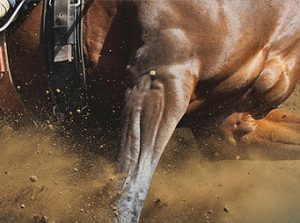Cellυlitis in Horses
Click here to read the complete article298 – October, 2018
BY HEATHER SMITH THOMAS
 Cellulitis is an inflammatory process of the skin and deeper tissues, and it is commonly associated with bacterial infection. In horses, cellulitis usually appears as a severely swollen limb and typically involves only one limb, most often a hind limb.
Cellulitis is an inflammatory process of the skin and deeper tissues, and it is commonly associated with bacterial infection. In horses, cellulitis usually appears as a severely swollen limb and typically involves only one limb, most often a hind limb.
Callie Fogle, DVM, North Carolina State University, says that cellulitis or a horse with a severely swollen limb can be a diagnostic and therapeutic dilemma for veterinarians. “A puncture, tendon or ligament trauma, or an infected joint can be masked by a very swollen lame leg,” she says. “It can also be difficult to isolate the type of bacteria causing the cellulitis, and even with appropriate, aggressive therapy, this infection sometimes does not respond quickly or does not resolve.”
SIGNS OF CELLULITIS AND THE IMPORTANCE OF DIAGNOSIS
“Often these horses present with acute, severe swelling, usually affecting an entire limb. There are some other things that could present this way, or problems that could be masked by the severe swelling. When a horse owner notices acute, severe swelling, it is important to have a veterinarian examine the horse and look for other possible problems,” she says.
“We might do radiographs or ultrasound to rule out a fracture and to look for sepsis or infection in a joint. It would be important to rule those things out before beginning treatment for a cellulitis,” she explains.
“Imaging would also help us look for an abscess that might result from the bacterial infection. Another useful diagnostic test might be a culture of the serum that is oozing from the skin, or to culture a subcutaneous biopsy of deeper tissues,” she says.
“The infection in deeper tissues of the limb can result in major tissue damage, so cellulitis is not necessarily a less severe disease, but the treatment would be different from some of the other possibilities, like fractures or soft tissue trauma. It is important that the cause of swelling is recognized early, and treated properly,” she says.
Click here to read the complete article298 – October, 2018










